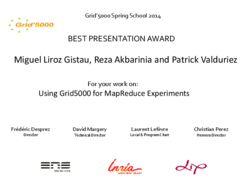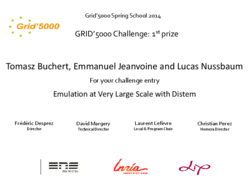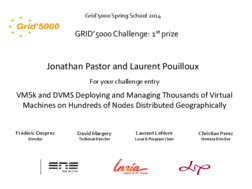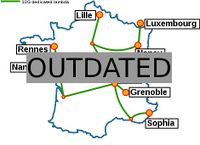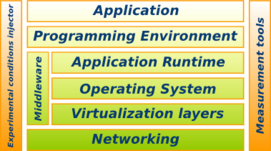Grid5000:Home: Difference between revisions
No edit summary |
No edit summary |
||
| Line 32: | Line 32: | ||
|} | |} | ||
---- | ---- | ||
=== Journée Aramis === | === Journée Aramis === | ||
Revision as of 12:05, 1 July 2014
|
|
Latest updates from Grid'5000 users
- Publications
Five random publications that benefited from Grid'5000 (at least 2517 overall):
- Chuyuan Li, Chloé Braud, Maxime Amblard. Multi-Task Learning for Depression Detection in Dialogs. 23rd Annual Meeting of the Special Interest Group on Discourse and Dialogue (SIGDIAL 2022), Sep 2022, Edinbourg, United Kingdom. pp.1-8, 10.48550/arXiv.2208.10250. hal-03724305 view on HAL pdf
- Daniel Rosendo. Methodologies for Reproducible Analysis of Workflows on the Edge-to-Cloud Continuum. Distributed, Parallel, and Cluster Computing cs.DC. INSA RENNES, 2023. English. NNT : . tel-04167278 view on HAL pdf
- Esteban Marquer, Safa Alsaidi, Amandine Decker, Pierre-Alexandre Murena, Miguel Couceiro. A Deep Learning Approach to Solving Morphological Analogies. 30th International Conference on Case-Based Reasoning (ICCBR2022), Sep 2022, Nancy, France. pp.159--174, 10.1007/978-3-031-14923-8_11. hal-03660625 view on HAL pdf
- Govind KP, Guillaume Pierre, Romain Rouvoy. Studying the Energy Consumption of Stream Processing Engines in the Cloud. IC2E 2023 - 11th IEEE International Conference on Cloud Engineering, IEEE, Sep 2023, Boston (MA), United States. pp.1-9. hal-04164074 view on HAL pdf
- Igor Fontana de Nardin, Patricia Stolf, Stéphane Caux. Mixing Offline and Online Electrical Decisions in Data Centers Powered by Renewable Sources. 48th Annual Conference of the IEEE Industrial Electronics Society (IECON 2022), IEEE Industrial Electronics Society (IES), Oct 2022, Brussels, Belgium. pp.1-6, 10.1109/IECON49645.2022.9968999. hal-03841611 view on HAL pdf
Latest news
Grid'5000 spring school now finished
The Grid'5000 spring school took place between June 16th, 2014 and June 19th, 2014 in Lyon. Three awards were given for presentation or challenge entries (the challenge entries ended as a tie):
|
Best presentation award to Miguel Liroz Gistau, Reza Akbarinia and Patrick Valduriez |
Best challenge entry to Tomasz Buchert, Emmanuel Jeanvoine and Lucas Nussbaum |
Best challenge entry to Jonathan Pastor and Laurent Pouilloux |
Journée Aramis
Le 16/04 aura lieu la journée Aramis "Usages et services du cloud dans notre environnement enseignement supérieur et recherche" avec une présentation de Grid'5000 par Simon Delamare.
Cette journée est webcastée par la cellule Webcast du CC-IN2P3. Vous pouvez donc suivre en direct les présentations. Le programme de la journée est disponible ici
Grid'5000 Charter revised
The Grid'5000 charter has been reworded and simplified so as to be more inclusive about possible uses. The rules to ensure availability during the day for any user and during the night for large resource usage have not been changed.
Grid'5000 school 2014 announced
Organized in Lyon, from June 16th to June 19th 2014, this spring school will bring together, but is not limited to, Grid'5000's users, technical team and executive committee for 4 days of tutorials and talks focusing on best-practices and results. Presentations and practical sessions will cover both basic usage of the platform, for new users, or potential users of Grid'5000 and advanced and new usage of the platform, for current users. Deadline to submit presentation proposals is March 29th, 2014.
Grid'5000 users win second prize at CCGRID 2013's SCALE challenge
Snooze based entry running on Grid'5000 entry wins 2nd prize at CCGrid 2013 SCALE challenge: well done Matthieu and Anne-Cécile for defending the entry titled Scalability of the Snooze Autonomic Cloud Management System by Eugen Feller, Christine Morin, Matthieu Simonin, Anne-Cécile Orgerie, and Yvon Jégou.
Grid'5000 users finalists of the SCALE'2013 challenge
Two submissions (out of five) from Grid'5000 users took part in the final of the international SCALE'2013 challenge (held with CCGrid'2013):
- D. Balouek, A. Lèbre, F. Quesnel Flauncher and DVMS -- Deploying and Scheduling Thousands of Virtual Machines on Hundreds of Nodes Distributed Geographically
- Eugen Feller, Christine Morin, Matthieu Simonin, Anne-Cécile Orgerie, and Yvon Jégou -- Scalability of the Snooze Autonomic Cloud Management System.
The first proposition presents the deployment and scheduling of thousands of virtual machines, conducted with the Flauncher and DVMS frameworks, across the Grid'5000 testbed. The frameworks have been able to deploy and schedule up to 10000 VMs during the tests. This research has been conducted in the context of the INRIA Hemera initiative.
The second proposition presents the Snooze architecture and focus on the following aspects :
- System set up scalability and resources consumption,
- Self-healing capabilities.
The deployment of Snooze were distributed over several sites of the Grid'5000 testbed. The framework has been able to start 11000 of system services, recover thousands of failures and used to launch large hadoop/mapreduce experiments. This research has been conducted in the context of the INRIA Snooze ADT.
Grid'5000 tutorial during ComPAS'2013
The ComPAS'2013 conference (replacing RenPar, SympA and CFSE), to be held in Grenoble between January 15th and 18th, will feature a Grid'5000 tutorial.
Grid'5000 at a glance
- Grid'5000 is a scientific instrument for the study of large scale parallel and distributed systems. It aims at providing a highly reconfigurable, controlable and monitorable experimental platform to its users. The initial aim (circa 2003) was to reach 5000 processors in the platform. It has been reframed at 5000 cores, and was reached during winter 2008-2009.
- The infrastructure of Grid'5000 is geographically distributed on different sites hosting the instrument, initially 9 sites in France (10 since 2011). Porto Alegre, Brazil is now officially becoming the first site abroad.
Sites:
- Grid'5000 is a research effort developing a large scale nation wide infrastructure for large scale parallel and distributed computing research.
- 19 laboratories are involved in France with the objective of providing the community a testbed allowing experiments in all the software layers between the network protocols up to the applications.
The current plans are to extend from the 9 initial sites each with 100 to a thousand PCs, connected by the RENATER Education and Research Network to a bigger platform including a few sites outside France not necessarily connected through a dedicated network connection. Sites in Brazil and Luxembourg should join shortly, and Reims has now joined.
All sites in France are connected to RENATER with a 10Gb/s link, except Reims, for the time linked through a 1Gb/s
This high collaborative research effort is funded by INRIA, CNRS, the Universities of all sites and some regional councils.
ALADDIN-G5K : ensuring the development of Grid'5000
For the 2008-2012 period, Engineers ensuring the development and day to day support of the infrastructure are mostly provided by INRIA, under the ADT ALADDIN-G5K initiative.
HEMERA: Demonstrating ambitious up-scaling techniques on Grid'5000
Héméra is an INRIA Large Wingspan project, started in 2010, that aims at demonstrating ambitious up-scaling techniques for large scale distributed computing by carrying out several dimensioning experiments on the Grid’5000 infrastructure, at animating the scientific community around Grid’5000 and at enlarging the Grid’5000 community by helping newcomers to make use of Grid’5000.
Initial Rationale
The foundations of Grid'5000 have emerged from a thorough analysis and numerous discussions about methodologies used for scientific research in the Grid domain. A report presents the rationale for Grid'5000.
In addition to theory, simulators and emulators, there is a strong need for large scale testbeds where real life experimental conditions hold. The size of Grid'5000, in terms of number of sites and number of processors per site, was established according to the scale of the experiments and the number of researchers involved in the project.
Current funding
As from June 2008, INRIA is the main contributor to Grid'5000 funding.
INRIA |
CNRS |
UniversitiesUniversity Joseph Fourier, Grenoble |
Regional councilsAquitaine |

